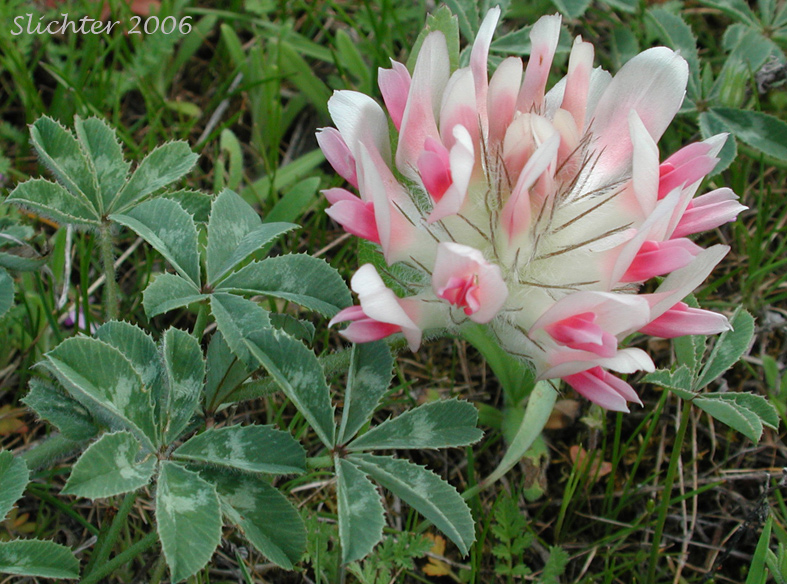 The
photo at right shows a close-up of the calyx and corolla of big-head clover
as seen along the Dalles Mt. Road in the Columbia Hills to the north of The
Dalles, OR............April 9, 2006. Note the long, slender calyx lobes
with numerous soft, spreading hairs and the long wings and banner of the corolla.
The
photo at right shows a close-up of the calyx and corolla of big-head clover
as seen along the Dalles Mt. Road in the Columbia Hills to the north of The
Dalles, OR............April 9, 2006. Note the long, slender calyx lobes
with numerous soft, spreading hairs and the long wings and banner of the corolla.
Characteristics:
Big-head clover is a very attractive perennial wildflower in terms of both is large, striped leaves and large, showy inflorescence. Several stems arise 10-30 cm high from a thick, tough root and spreading rhizomes. The distinct leaves are palmately compound with 5-9 leaflets that are oblanceolate to obcordate in outline. The thick, leathery leaflets are noticeably ribbed due to the pinnately spreading veins and have serrate margins, the teeth being small and thin. A lighter colored stripe runs across the middle of the leaflet blade (as seen in photos on this page) which measures 12-25 mm long. The stipules are broad, leaf-like and deeply cleft or toothed.
A single, dense head of flowers measuring up to 5 cm wide and long is found atop each stem. The heads lack a subtending involucre and are very showy. Individual flowers measure 22-28 mm long and are pinkish to rose-pink with white banner. The pedicels are very short. The calyx is about 2/3 the length of the corolla and is tipped by long, thin calyx teeth that are several times longer than the calyx tube and are ringed with many fringing hairs. The small pods are typically 1-4 seeded.
Big-head clover may be found on rocky or shallow soils in grasslands, amongst sagebrush or in open ponderosa pione woodlands.
Big-head clover may be found wholly east of the Cascade Mts. from southcentral Washington to central Oregon and eastward to western Idaho and Nevada.
Several palmately compound leaves of bighead clover observed at left along the east rim of Canyon Creek in the Klickitat Wildlife Area........March 12, 2020. The photo at right shows the inflorescence of bighead clover to the south of Grayback Mountain, Klickitat Wildlife Area......May 7, 2020.
The photo above shows a close-up frontal view of the large, ascending banner and central, pink-tipped wings and keel of big-head clover as seen from the Dalles Mt. Road..........April 9, 2006.
The photo above shows a close-up view of the broad, attractive flower head and palmately compound leaves of big-head clover as seen along the Dalles Mt. Road (Columbia River Gorge)...........April 9, 2006. Note that this species of clover has more than 3 leaflets per each leaf, and note also the light rings marking the leaflets.
The photo above shows big-head clover as seen in oak woodlands in the upper Klickitat River Canyon several miles to the south of the Outlet Falls to Conboy Lake NWR..........May 3, 2008.







